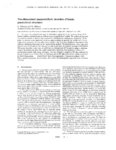|
|
Creator | Title | Description | Subject | Date |
| 176 |
 |
Zhdanov, Michael | Two-dimensional magnetotelluric inversion of blocky geoelectrical structures | This paper demonstrates that there are alternative approaches to the magnetotelluric (MT) inverse problem solution based on different types of geoelectrical models. The traditional approach uses smooth models to describe the conductivity distribution in underground formations. In this paper, we pres... | | 2002-01-01 |
| 177 |
 |
Zhdanov, Michael S. | 3-D magnetic inversion with data compression and image focusing | We develop a method of 3-D magnetic anomaly inversion based on traditional Tikhonov regularization theory. We use a minimum support stabilizing functional to generate a sharp, focused inverse image. An iterative inversion process is constructed in the space of weighted model parameters that acce... | | 2002-01-01 |
| 178 |
 |
Zhdanov, Michael | Contraction integral equation method in three-dimensional electromagnetic modeling | The integral equation method has been proven to be an efficient tool to model threedimensional electromagnetic problems . Owing to the full linear system to be solved, the method has been considered effective only in the case of models consisting of a strongly limited number of cells. However, recen... | | 2002-01-01 |
| 179 |
 |
Zhdanov, Michael S. | Localized S-inversion of time-domain electromagnetic data | Interpretation of time-domain electromagnetic (TDEM) data over inhomogeneous geological structures is a challenging problem of geophysical exploration. The most widely used approach of interpreting TDEM data is based on the smooth 1-D layered resistivity inversion. We have developed an effective t... | | 2002-01-01 |
| 180 |
 |
Miller, Jan D. | Characterization of spherical alumina particles obtained by melting in a hydrogen-oxygen flame | Spherical oxide particles can be used as mineral fillers, paint pigments, polishing materials and catalysts. They can be prepared using various techniques involving precipitation and spray drying. Melting of particles in a high-temperature flame is a simple technique which produces particles with ... | Alumina; Oxides; Hydrogen-oxygen flame | 2003 |
| 181 |
 |
Miller, Jan D. | Influence of surfactants on interaction forces between polyethylene surfaces in a hydrocarbon solvent | The polyolefins, mainly polyethylene and polypropylene particles, are used as an active filler material in polymer-polymer blends and are being used for the modification of asphalts to provide for high-load, low-maintenance road construction. The stability of prepared blends depends on the interact... | Surfactants; Asphalt; Polymer; Polyolefins | 2003 |
| 182 |
 |
Miller, Jan D. | Surfactant adsorption density calculation from Fourier transform infrared external reflection spectroscopy (FTIR/ERS) | An equation to calculate surfactant adsorption density from Fourier transform infrared external reflection spectra was established. The derivation and limitation of this equation are discussed in detail. The validation of the FTIR/ERS adsorption density equation was experimentally verified from t... | Surfactant; Adsorption density; Solid film | 2003 |
| 183 |
 |
Miller, Jan D.; Lin, Chen-Luh | 3D analysis of particulates in mineral processing systems by cone beam X-ray microtomography | In general, x-ray computed tomographic (CT) techniques are able to provide 3D images of the internal structure of opaque materials in a nondestructive manner. The unique cone beam geometry allows acquisition of all 2D projections with only one rotation of the sample thus providing for fast data acqu... | X-ray microtomography; Liberation; Heap leaching; Exposure analysis; Coal washability | 2003 |
| 184 |
 |
Miller, Jan D.; Lin, Chen-Luh | Particle size distribution for copper heap leaching operations as established from 3D mineral exposure analysis by X-ray microCT | The particle size distribution (PSD) for copper heap leaching is an important consideration in the design and operation of any copper heap leaching facility. High-resolution 3D X-ray microtomography (XMT) can be used for the direct determination of the percentage of exposed valuable mineral grains i... | Particle size distribution; Leaching; X-ray microtomography | 2003 |
| 185 |
 |
Zhdanov, Michael | Cross-well electromagnetic imaging in three dimensions | In this paper, we develop a new technique for 3D cross-well electromagnetic tomography, based on an EM borehole survey consisting of a moving vertical magnetic dipole transmitter, located in one or several boreholes, and a tri-axial induction receiver, located in the other boreholes. The method is b... | | 2003 |
| 186 |
 |
Miller, Jan D.; Nalaskowski, Jakub | Interaction forces between silica surfaces in aqueous solutions of poly(ethylene oxide)s | An understanding of forces responsible for the stability of dispersions of colloidal particles when interacting with each other in aqueous solutions is of great interest academically and industrially. When water-soluble polymers are adsorbed onto colloidal particles, various effects on the stabil... | Water-soluble polymers; Colloidal particles; Interaction forces | 2003 |
| 187 |
 |
Reichler, Thomas J. | Determining the tropopause height from gridded data | A method is presented to determine tropopause height from gridded temperature data with coarse vertical resolution. The algorithm uses a thermal definition of the tropopause, which is based on the concept of a threshold lapse-rate. Interpolation is performed to identify the pressure at which this th... | Meteorology and Atmospheric Dynamics: Stratosphere/troposphere interactions; Numerical modeling and data assimilation; Meteorology; Atmospheric Dynamics: General circulation | 2003 |
| 188 |
 |
Miller, Jan D.; Fang, Zhigang Zak; Lin, Chen-Luh | Characterization of powder injection molded components using X-ray CT | A good understanding of the microstructure of powder injection molded (PIM) components during debinding and sintering is essential in designing and optimizing PIM processes and properties. So far we have been limited in our ability to "see" what is going on. Microstructural characterization has cla... | Powder injection molding | 2003 |
| 189 |
 |
Miller, Jan D. | Thiocarbonate collectors in pyrite flotation ? fundamentals and applications | Recent results from electrochemical measurements demonstrate that trithiocarbonate (TTC) collectors are more readily oxidized to their corresponding dithiolates than the dithiocarbonate/xanthate (DTC) collectors. Based on the traditional analysis of collector adsorption, trithiocarbonates might then... | Trithiocarbonate; xanthate; nitrogen | 2003 |
| 190 |
 |
Brown, Francis Harold | Gombe group basalts and initiation of pliocene deposition in the Turkana depression, northern Kenya and southern Ethiopia | A little before 4 Ma ago, deposition of Pliocene and Pleistocene strata described as the Omo Group began in the Turkana and Omo basins of northern Kenya and southern Ethiopia. Soon after, basaltic magma erupted as thin lava flows, and intruded as dykes into the oldest Pliocene strata of the basin. T... | | 2004 |
| 191 |
 |
Jarrard, Richard D. | Data report: high-resolution mineralogy for leg 199 based on reflectance spectroscopy and physical properties | During Ocean Drilling Program Leg 199 in the equatorial Pacific, visible and near-infrared spectroscopy (VNIS) was used to measure the reflectance spectra (350?2500 nm) of 1343 sediment samples. Reflectance spectra were also measured for a suite of 60 samples of known mineralogy, thereby providing a... | | 2004 |
| 192 |
 |
Zhdanov, Michael S. | Three-dimensional regularized focusing inversion of gravity gradient tensor component data | We develop a new method for interpretation of tensor gravity field component data, based on regularized focusing inversion. The focusing inversion makes its possible to reconstruct a sharper image of the geological target than conventional maximum smoothness inversion. This new technique can be eff... | Focusing inversion; Gravity gradient; Gravity gradiometry | 2004 |
| 193 |
 |
Brown, Francis Harold | Geological development of the Omo-Turkana Basin during the pliocene and pleistocene epochs | Pliocene and Pleistocene deposits of the Omo-Turkana Basin extend from 6?N latitude to about 2?N latitude (-450 km), and laterally from about 35.5?E to 36.5?E. Sediments are brought to the basin by the Omo River which rises in Ethiopia, and by the Turkwel and Kerio Rivers which rise in Kenya and Uga... | | 2004 |
| 194 |
 |
Miller, Jan D. | Three dimensional analysis of particulates in mineral processing systems by cone beam X-ray microtomography | In general, X-ray-computed tomographic (CT) techniques are capable of providing three-dimensional images of the internal structure of opaque materials in a nondestructive manner. The unique cone beam geometry allows acquisition of all two-dimensional projections with only one rotation of the sample,... | Cone beam CT; X-ray microtomography; Liberation analysis; Particle shape; Heap leaching; Exposure analysis; Coal washability | 2004 |
| 195 |
 |
Zhdanov, Michael | Quasi-analytical boundary condition for three-dimensional finite difference electromagnetic modeling | Numerical modeling of the quasi-static electromagnetic (EM) field in the frequency domain in a three-dimensional (3-D) inhomogeneous medium is a very challenging problem in computational physics. We present a new approach to the finite difference (FD) solution of this problem. The FD discretization ... | | 2004-01-01 |
| 196 |
 |
Miller, Jan D. | New developments in mixing, flocculation and flotation for industrial wastewater pretreatment and municipal wastewater treatment | Solid/liquid separations are commonly the first step in any wastewater treatment. Such technologies are mature and new developments are rare. However, in the last decade some significant improvements in separation techniques for industrial waste water pretreatment have been implemented. Advances in ... | Wastewater treatment; Flocculation; Flotation; Industrial wastewater pretreatment; Sludge thickening; Mixing | 2005 |
| 197 |
 |
Miller, Jan D. | Arsenic removal from contaminated waters | Arsenic is a contaminant at 781 of 1,430 sites identified on the National Priorities List and in mining and mineral processing wastewaters, smelter wastes, and sites for manufacture of semiconductors, petroleum products, wood preservatives, animal feed additives, and herbicides. Arsenic affects abo... | Arsenic; Arsenate; Arsenite; Microbial; Activated carbon; Magnetic activated carbon; Biomac | 2005 |
| 198 |
 |
Miller, Jan D. | Significance of electrokinetic characterization for interpreting interfacial phenomena at planar, macroscopic interfaces | Streaming potential measurements provide valuable information for the validation and interpretation of interfacial phenomena that occur at flat macroscopic surfaces. Planar substrates have been extensively used for the interpretation of events, which occur at particulate surfaces; however, these fla... | Interfacial phenomena; Surface charge | 2005 |
| 199 |
 |
Miller, Jan D. | Dimethyl ether - a new synthetic fuel commodity and chemical building block | Dimethyl ether (DME) is recognized as a potential next-generation, environmentally benign commodity for energy storage and distribution, as well as a momentous chemical building block. DME can be produced at a competitive price from synthesis gas conveniently generated from a variety of carbon-cont... | Dimethyl ether; DME; Energy carrier; Energy commodity; Diesel fuel | 2005 |
| 200 |
 |
Miller, Jan D. | Air-sparged hydrocyclone (ASH) technology for cyanide recovery | An air-sparged hydrocyclone (ASH) mobile system was evaluated for continuous stripping and recovery of cyanide (the AVR process) from process water at a gold plant site. The ASH unit performed exceptionally well as an absorber. HCN was absorbed from the gas phase in a single pass with an efficiency... | Cyanide recovery; Air-sparged hydrocyclone; Gold processing; Process water | 2005 |

























